Historical School Buildings. A Multi-Criteria Approach for Urban Sustainable Projects
Abstract
1. Introduction
- the Circular n° 425/1967 of the Public Works (Studies and Planning Service) Ministry concerning building and urban planning standards, in particular the Appendix C of the aforementioned Circular contains indications on influence radius to be assumed for the identification of the territorial area in which the school is;
- the Ministerial Decree (MD) (Ministry of Public Works in agreement with the Ministry of Public Education) of 18/12/1975 (Updated technical standards relating to school building) [31];
- the Law n° 23/1996 (Regulations on school building) [32];
- the Legislative Decree n° 106/2009 (concerning the protection of health and safety in the workplace) [33];
- the Agreement of 18 November 2010 according to Article 9 of Legislative Decree of 27 August 1997, n° 281, between the Government, regions, autonomous provinces of Trento and Bolzano, provinces and municipalities (Guidelines for the prevention of indoor risk factors for allergies and asthma in schools) [34];
- the Ministerial Decree (Ministry of Infrastructure and Transport) of 17 January 2018 (Technical Regulations for Construction, in particular Chapter 8, which contains the anti-seismic safety parameters to be followed by existing structures) [35];
- the Law n° 107/2015 (Reform of the national education and training system and delegation for the reorganization of current legislative provisions) [36];
- internal architecture of schools, by the Education, University and Research Ministry after hearing the Unified Conference (MD 11 April 2013), bearing the technical standards-framework, containing the minimum and maximum indices of urban functionality, construction, also with reference to technologies in the field of efficiency and energy saving and production from renewable energy sources, and teaching, to ensure appropriate and homogeneous reference design guidelines on the national territory [38];
- recommendations for the energy upgrading of school buildings, produced by the Italian Ente per le Nuove tecnologie, l’Energia e l’Ambiente (ENEA) aimed to disseminate knowledge and operational tools at the basis of the energy upgrading of buildings for training, following an updated approach to the latest regulations and the current possibilities for economic incentives [39] for a healthy school environment in Europe.
- environmental quality in external and internal spaces of European schools, in 2015 the pilot project SINPHONIE (Indoor Pollution in Schools and Health—European Observatory) [40], funded by the European Parliament and supported by the European Commission, aimed at investigating the quality of air inside and outside school environments, and the effects that pollutants can have on the health of school users. Through the SINPHONIE pilot project, it was possible to establish methodologies and define standardized tools for characterizing school interiors and assessing health risks for students and staff, in order to maintain a healthy and livable school environment [41,42,43].
2. Materials
2.1. Premise
2.2. Regulatory Overview and In-Depth Analysis of the Main Italian Legislative Measures for School Construction
- Ministerial Decree (MD) of 18 December 1975, which illustrates the Technical Standards referring to school buildings, including the educational, building and urban planning functionality indices, to be observed in the design and verification of interventions on existing schools. These indices vary according to the type of study courses and the morphological-urban characteristics of the urban context in which the school building is located. The same MD also distinguishes between indoor spaces (units for teaching and special activities, sanitary facilities, indoor gyms, administrative offices, classrooms for common events) and outdoor ones (outdoor sports fields and parking areas);
- Law n° 23/1996 (School Building Regulations), aimed at the construction of a national information system on existing school buildings resulting from the collection of data on the state of maintenance, the safety level of existing school structures and the rate of usability of the same by the community in extra-educational time. With the above law, Anagrafe dell’Edilizia Scolastica (AES), with which the management of interventions on school building at national and regional level is carried out, is established;
- Legislative Decree n° 106/2009, which contains additional and corrective provisions to Legislative Decree n° 81/2008, on the protection of health and safety in the workplace, especially with regard to the presence of materials containing asbestos;
- Agreement of 18 November 2010 pursuant to Article 9 of Legislative Decree n° 281/1997, for the implementation of project initiatives aimed at preventing indoor risk factors for allergies and asthma in schools;
- Ministerial Decree of 14 April 2013, containing the new guidelines of reference for the construction of new schools, also with regard to technologies in the field of energy efficiency and saving and production from renewable energy sources, and teaching. The provisions contained in this MD, of a performance type, deviate from the prescriptive style of the previous illustrated in the MD of 18 December, 1975;
- Law n° 107/2015 (“Good School Law”), specifically aimed at describing the objectives to be pursued in the design and implementation of “innovative schools” from an architectural, plant engineering, technical-construction, energy, anti-seismic and fire safety point of view. This law identifies the types of extra-educational functions at the service of the community to which to allocate part of the school space;
- ENEA guide published on 19 April 2016, which also illustrates the types of intervention related to the building envelope, lighting and daylight, heating systems, renewable energy and water management to be implemented for the redevelopment of a school building;
- Ministerial Decree of 17 January 2018, containing provisions on anti-seismic safety to be taken into account when intervening in the construction, as in the case of existing schools;
- Law n° 81/2019, which illustrates certain provisions for the adaptation of existing school buildings to the requirements of the fire regulations.
Description of the Information Contained in the Data Sheet for School Buildings
- extension and/or super-elevation: a complex of works that have the effect of enlarging an existing building, creating additional spaces or volumes. The extension can be done by “horizontal addition” (in which case it involves an increase in coverage), or “vertical addition” (i.e., elevation), or finally with actions of both expansion and elevation;
- building renovation: interventions aimed at transforming building organizations through a systematic set of works that can lead to a building organization in whole or in different parts. These interventions include the restoration or replacement of certain elements of the building, or even the elimination, modification and insertion of new elements and systems;
- integral and conservative restoration: interventions aimed at preserving the building organism and ensuring its functionality through a systematic works set that—in compliance with the typological, formal and structural elements of the building organism—allow its compatible use with them. These interventions include: the consolidation, restoration and renewal of the building’s constituent elements; the insertion of ancillary elements and systems required by the use needs; the elimination of extraneous elements to the building organism;
- extraordinary maintenance: works aimed at renovating and replacing parts, including structural ones, of buildings, as well as the construction and integration of sanitary and technological services, while respecting the volumes and surfaces of the individual building units.
3. Evaluation Framework
3.1. Knowledge Phase
3.1.1. Collection of Data to Describe the School of Interest from a Historical, Technical (Structural, Technological, Plant Engineering) and Architectural Point of View, According to its Own Training Plan and the Active Extra-Didactic Services Offered to the Community
3.1.2. Socio-Economic Analysis of the Urban Context
3.2. Evaluation Phase
3.2.1. Evaluations of Consistency According to the Technical and Regulatory Requirements to Be Complied with at the Design Stage and the Actual State of the School
- a)
- the value of the parameter Lf is assigned on the basis of the increase and decrease in the surface index deriving from the direct survey of school spaces (internal and external) (If) with respect to the parameter of law If*. Figure 2 below shows the extremes of the incremental and decremental intervals (∆If), expressed in percentages, defined starting from the If* value and the average Li_f score to be assigned to the i-th space according to the corresponding ∆Ifi.
- b)
- With regard to the structural aspect, the corresponding evaluation index (Ls) is measured according to the number of rooms, used for teaching and not, distributed on each floor of the school building, which at the time of the on-site inspection are unusable and risky for the safety of school users. Figure 3 below shows the interval extremes, expressed as a percentage, established on the basis of the number of currently unusable environments (Nai) defined with respect to the total number of spaces (Ntot) present on each school level, and the average score to be assigned, according to the values scale [1,2,3,4,5,6], in descending order on the basis of the number of impassable spaces by the persons surveyed at the time of the inspection.
- c)
- As far as fire safety is concerned, the corresponding evaluation index (La) is measured taking into account the obligation deriving from the law (Law 81/2019) to provide each environment with appropriate fire protection devices (e.g., fire extinguishers, which are not exhaustive) with particular performance characteristics. In particular, the attribution of a high, or low, numerical value to the La index can be related to the frequency (in percentage terms) of spaces in correspondence with each floor of the school building, in which the presence, or absence, of fire extinguishers or other devices for fire risk prevention is found, compared to the total number of rooms on the same floor. Figure 4 below shows the reference diagram for the assignment of the score to the parameter (La) as a function of the frequency of the rooms without fire-fighting devices (Ne) compared to the total number (Ntot) of spaces on the i-th floor.
- d)
- With reference, instead, to the hygienic-sanitary aspect, it is possible to refer to the possible presence of superficial condensation inside the spaces specifically destined to the carrying out of didactic activities. Similar to the previous evaluation indexes described above, the value assumed by Li-s is related to the number of rooms on each floor within which there are forms of surface condensation (Ns) compared to the total spaces (Ntot) on the i-th floor.
3.2.2. Identification of the Methods of Actions and Types of Interventions to Be Implemented in the Event of Non-Compliance with the Minimum Regulatory Requirements Regarding Security and Physical-Functional Management of the School Space
4. Case Study
4.1. Knowledge Phase
4.1.1. Description of the School from the Historical, Technical and Architectural Point of View, According to Its Own Training Plan and the Extra-Educational Services Offered to the Community
4.1.2. Socio-Economic Analysis of the Urban Context in which the School Is Located
4.2. Evaluation Phase
4.2.1. Congruence Check between the Technical and Regulatory Requirements and the Actual State of the School
4.2.2. Identification of Types of Interventions to Be Implemented in Case of Non-Compliance with the Minimum Regulatory Requirements Regarding Safety and Use of School Space
5. Conclusions
Author Contributions
Funding
Conflicts of Interest
References
- Garett, S.; Portney, K.E. Sustainable Cities. Policies and Healthy Cities. In Integrating Human Health into Urban and Transport Planning; Nieuwenhuijsen, M., Khries, H., Eds.; Springer: Cham, Switzerland, 2019; pp. 31–49. [Google Scholar]
- McCormick, K.; Anderberg, S.; Coenen, L.; Neij, L. Advancing sustainable urban transformation. J. Clean. Prod. 2013, 50, 1–11. [Google Scholar] [CrossRef]
- Diaz-Sarachaga, J.M. Analysis of the Local Agenda 21 in Madrid Compared with Other Global Actions in Sustainable Development. Int. J. Env. Res. Pub Heal. 2019, 16, 3685. [Google Scholar] [CrossRef] [PubMed]
- De Roo, G.; Donald, M. Compact Cities and Sustainable Urban Development: A Critical Assessment of Policies and Plans from an International Perspective; Routledge: New York, NY, USA, 2019. [Google Scholar]
- Nesticò, A.; Sica, F. The sustainability of urban renewal projects: A model for economic multi-criteria analysis. J. Prop. Invest. Financ. 2017, 35, 397–409. [Google Scholar] [CrossRef]
- Della Spina, L. Scenarios for a Sustainable Valorisation of Cultural Landscape as Driver of Local Development. In New Metropolitan Perspectives. ISHT 2018. Smart Innovation, Systems and Technologies; Calabrò, F., Della Spina, L., Eds.; Springer: Cham, Switzerland, 2018; Volume 100, pp. 113–122. [Google Scholar] [CrossRef]
- Della Spina, L.; Calabrò, F. Decision Support Model for Conservation, Reuse and Valorization of the Historic Cultural Heritage. In Computational Science and Its Applications—ICCSA 2018. ICCSA 2018. Lecture Notes in Computer Science; Gervasi, O., Murgante, B., Eds.; Springer: Cham, Switzerland, 2018; Volume 10962, pp. 3–17. [Google Scholar]
- European Commission. Leipzig Charter on Sustainable European Cities and Towns, CdR 163/2007 EN-COM/SAB/lc. 2007. Available online: https://ec.europa.eu/regional_policy/archive/themes/urban/leipzig_charter.pdf (accessed on 20 January 2020).
- European Commission. The State of European Cities: Cities Leading the Way to a Better Future; Publications Office of the European Union: Luxembourg, 2016. Available online: http://ec.europa.eu/regional_policy/sources/policy/themes/citiesreport/state_eu_cities2016_en.pdf (accessed on 8 November 2019).
- Della Spina, L.; Calabrò, F. Pianificazione strategica: Valutare per programmare e governare lo sviluppo. LaborEst 2015, 11, 3–4. [Google Scholar]
- Directive 2012/27/EU of the European Parliament and of the Council of 25 October 2012 on energy efficiency, amending Directives 2009/125/EC and 2010/30/EU and repealing Directives 2004/8/EC and 2006/32/EC. Available online: https://eur-lex.europa.eu/legal-content/IT/TXT/PDF/?uri=CELEX:32012L0027&from=EN (accessed on 8 November 2019).
- Directive (EU) 2016/2284 of the European Parliament and of the Council of 14 December 2016 on the reduction of national emissions of certain atmospheric pollutants, amending Directive 2003/35/EC and repealing Directive 2001/81/EC. Available online: https://eur-lex.europa.eu/legal-content/IT/TXT/PDF/?uri=CELEX:32016L2284&from=EN (accessed on 8 November 2019).
- Legislative Decree no. 102 of 4 July 2014 on Energy Efficiency (in the Official Journal 18 July 2014, n° 165). Available online: https://www.normattiva.it/uri-res/N2Ls?urn:nir:stato:decreto.legislativo:2014-07-04;102!vig= (accessed on 8 November 2019).
- Balocco, C.; Colaianni, A. Assessment of Energy Sustainable Operations on a Historical Building. The Dante Alighieri High School in Florence. Sustainability 2018, 10, 2054. [Google Scholar] [CrossRef]
- Corrado, V.; Ballarini, I.; Paduos, S.; Tulipano, L. A new procedure of energy audit and cost analysis for the transformation of a school into a nearly zero-energy building. Energy Procedia 2017, 140, 325–338. [Google Scholar] [CrossRef]
- De Berardinis, P.; Rotilio, M.; Capannolo, L. Energy and Sustainable Strategies in the renovation of existing buildings: An Italian Case Study. Sustainability 2017, 9, 1472. [Google Scholar] [CrossRef]
- Loreti, L.; Valdiserri, P.; Garai, M. Dynamic simulation on energy performance of a school. Energy Procedia 2016, 101, 1026–1033. [Google Scholar] [CrossRef]
- Guarini, M.R.; Morano, P.; Sica, F. Integrated Ecosystem Design: An Evaluation Model to Support the Choice of Eco-Compatible Technological Solutions for Residential Building. Energies 2019, 12, 2659. [Google Scholar] [CrossRef]
- Asdrubali, F.; Calcagnini, L.; Evangelisti, L.; Guattari, C.; Marrone, P. Effectiveness of Materials, Technologies, and Renewable Energy in Educational Buildings Through Cluster Analysis of Energy Retrofitting. In Sustainable Building for a Cleaner Environment: Selected Papers from the World Renewable Energy Networks Med Green Forum 2017; Sayigh, A., Ed.; Springer: Cham, Switzerland, 2019; pp. 25–37. [Google Scholar] [CrossRef]
- D’Agostino, D. Improving Energy Efficiency in Buildings: Challenges and Opportunities in the European Context. Sustainability through Energy-Efficient Buildings; CRC Press: New York, NY, USA, 2018; pp. 181–208. [Google Scholar]
- Baggio, M.; Tinterri, C.; Dalla Mora, T.; Righi, A.; Peron, F.; Romagnoni, P. Sustainability of a historical building renovation design through the application of LeeD® rating system. Energy Procedia 2017, 113, 382–389. [Google Scholar] [CrossRef]
- Della Spina, L. Historical Cultural Heritage: Decision Making Process and Reuse Scenarios for the Enhancement of Historic Buildings. In New Metropolitan Perspectives. ISHT 2018. Smart Innovation, Systems and Technologies; Calabrò, F., Della Spina, L., Bevilacqua, C., Eds.; Springer: Cham, Switzerland, 2019; Volume 101, pp. 442–453. [Google Scholar] [CrossRef]
- Available online: http://www.dt.tesoro.it/export/sites/sitodt/modules/documenti_it/patrimonio_pubblico/patrimonio_pa/RapportoImmobili_DatiAnno2016.pdf (accessed on 20 January 2020).
- Ministry of Education, University of Research—Single School Data Portal. Available online: https://dati.istruzione.it/opendata/esploraidati/ (accessed on 19 December 2019).
- Ministry of Education, University of Research—School building portal - registry office. Available online: https://www.istruzione.it/edilizia_scolastica/anagrafe.shtml (accessed on 19 December 2019).
- Vitale, V.; Salerno, G. A numerical prediction of the passive cooling effects on thermal comfort for a historical building in Rome. Energy Build. 2017, 157, 1–10. [Google Scholar] [CrossRef]
- Vogel, C. Recovery High Schools. Dist. Adm. 2009, 45, 37–40. [Google Scholar]
- Patel, S.; Natalie, C. Student and staff social dynamics and transitions during school redesign. Improv. Sch. 2019, 22, 158–172. [Google Scholar] [CrossRef]
- Green, T.L. School as community, community as school: Examining principal leadership for urban school reform and community development. Educ. Urban Soc. 2018, 50, 111–135. [Google Scholar] [CrossRef]
- Salvado, F.; de Almeida, N.M.; Azevedo, Á.V.E. Historical analysis of the economic life-cycle performance of public school buildings. Build. Res. Inf. 2019, 47, 1–20. [Google Scholar] [CrossRef]
- MD December 18, 1975 (in G.U. February 2, 1976 n° 29): Updated technical standards relating to school building. including building and town planning functionality indexes. to be observed when carrying out school building works. Available online: https://www.indicenormativa.it/norma/urn%3Anir%3Aministero.lavori.pubblici%3Adecreto%3A1975-12-18 (accessed on 20 January 2020).
- Law n° 23 of January 11, 1996 (in G.U. no. 15—General Series—of January 19, 1996). Standards for school building. Available online: https://www.normattiva.it/uri-res/N2Ls?urn:nir:stato:legge:1996;23 (accessed on 20 January 2020).
- Legislative Decree n° 106 of August 3, 2009. Supplementary and corrective provisions of Legislative Decree n° 81 of April 9, 2008 on the protection of health and safety in the workplace (in G.U. n° 180 of August 5, 2009). Available online: http://www.bosettiegatti.eu/info/norme/statali/2009_0106.htm (accessed on 20 January 2020).
- Agreement, pursuant to Article 9 of Legislative Decree n°. 281 of August 27, 1997, between the Government, regions, autonomous provinces of Trento and Bolzano, provinces, municipalities and mountain communities concerning “Guidelines for the prevention of indoor risk factors for allergies and asthma in schools” (in G.U. General Series no. 9 of 13-01-2011). Available online: https://www.normattiva.it/uri-res/N2Ls?urn:nir:stato:decreto.legislativo:1997-08-28;281 (accessed on 20 January 2020).
- MD of January 17, 2018: Update of “Technical standards for construction” (in G.U. General Series n° 42 of 20-02-2018). Available online: https://www.gazzettaufficiale.it/eli/gu/2018/02/20/42/so/8/sg/pdf (accessed on 20 January 2020).
- Law n° 107 of July 13, 2015 (1). Reform of the national education and training system and delegation for the reorganization of the current legislative provisions (in G.U. General Series n° 162 of 15-07-2015). Available online: https://www.gazzettaufficiale.it/eli/id/2015/07/15/15G00122/sg (accessed on 20 January 2020).
- Law n° 81 of August 8, 2019 (art. 4-bis: Adaptation to fire regulations of school buildings in G.U. General Series n° 188 of 12-08-2019). Available online: https://www.gazzettaufficiale.it/eli/id/2019/08/12/19G00090/sg (accessed on 20 January 2020).
- MD April 11, 2013: Technical standards, containing the minimum and maximum indices of urban planning, building, also with reference to technologies for energy efficiency and energy saving and production from renewable energy sources, and teaching, to ensure adequate and homogeneous design guidelines on the national territory. Available online: https://www.edscuola.eu/wordpress/?p=20651 (accessed on 20 January 2020).
- ENEA. Guide to energy efficiency in school buildings. Available online: http://www.efficienzaenergetica.enea.it/scuolesostenibili. (accessed on 20 January 2020.).
- Csobod, E.; Annesi-Maesano, I.; Carrer, P.; Kephalopoulos, S.; Madureira, J.; Rudnai, P.; De Oliveira Fernandes, E.; Barrero, J.; Beregszászi, T.; Hyvärinen, A.; et al. SINPHONIE—Schools Indoor Pollution and Health Observatory Network in Europe—Final Report. EUR 26738; Publications Office of the European Union: Luxembourg, 2014; ISBN 978-92-79-39407-2. [CrossRef]
- Lu, Y.; Zhang, X.P.; Huang, Z.; Lu, J.; Wang, D. Impact of introducing penalty-cost on optimal design of renewable energy systems for net zero energy buildings. Appl. Energy 2019, 235, 106–116. [Google Scholar] [CrossRef]
- Pasimeni, M.R.; Valente, D.; Zurlini, G.; Petrosillo, I. The interplay between urban mitigation and adaptation strategies to face climate change in two European countries. Environ. Sci. Policy 2019, 95, 20–27. [Google Scholar] [CrossRef]
- Iannone, F.; Carbonara, G.; Rinaldi, A.; D’Elia, M.; Dell’Osso, G.R. Building automation system to control natural ventilation in school buildings. The case study of “Michelangelo School” in Bari. Tema Technol. Eng. Mater. Archit. 2019, 5, 117–129. [Google Scholar]
- Ozsezer, M.; Tufan, H.; Ozkul, A.E. Historical development of the school for deaf children which was opened in Cyprus under the British Administration. Qual. Quant. 2018, 52, 1421–1435. [Google Scholar] [CrossRef]
- Campbell, C.; Sherington, G. The comprehensive Public High School: Historical Perspectives; Palgrave Macmillan: New York, NY, USA, 2013. [Google Scholar]
- Cardinale, T.; Colapietro, D.; Cardinale, N.; Fatiguso, F. Evaluation of the efficacy of traditional recovery interventions in historical buildings. A new selection methodology. Energy Procedia 2013, 40, 515–524. [Google Scholar] [CrossRef]
- National Institute for Documentation Innovation Educational Research, PON-GIES Project—Management of School Building Interventions. Available online: http://gies.indire.it (accessed on 19 December 2019).
- Tarragüel, A.A.; Krol, B.; Van Westen, C. Analysing the possible impact of landslides and avalanches on cultural heritage in Upper Svaneti, Georgia. J. Cult. Herit. 2012, 13, 453–461. [Google Scholar] [CrossRef]
- Huang, M.; Bo, W. Evaluating green performance of building products based on gray relational analysis and analytic hierarchy process. Environ. Prog. Sustain. Energy 2014, 33, 1389–1395. [Google Scholar] [CrossRef]
- Pardo-Bosch, F.; Aguado, A.; Pino, M. Holistic model to analyze and prioritize urban sustainable buildings for public services. Sustain. Cities Soc. 2019, 44, 227–236. [Google Scholar] [CrossRef]
- Nesticò, A.; Morano, P.; Sica, F. A model to support the public administration decisions for the investments selection on historic buildings. J. Cult. Herit. 2018, 33, 201–207. [Google Scholar] [CrossRef]
- Macharis, C.; Turcksin, L.; Lebeau, K. Multi actor multi criteria analysis (MAMCA) as a tool to support sustainable decisions: State of use. Decis. Support Syst. 2012, 54, 610–620. [Google Scholar] [CrossRef]
- Morano, P.; Locurcio, M.; Tajani, F.; Guarini, M. Fuzzy logic and coherence control in multi-criteria evaluation of urban redevelopment projects. In International Journal of Business Intelligence and Data Mining; Azevedo, A., Santos, M.F., Eds.; Business Science Reference: Hershey, PA, USA, 2015; pp. 73–93. [Google Scholar] [CrossRef]
- Morano, P.; Tajani, F. Estimative analysis of a segment of the bare ownership market of residential property. In Computational Science and Its Applications, ICCSA 2013: 13th International Conference [...] Proceedings, Part IV. LECTURE NOTES IN COMPUTER SCIENCE; Murgante, B., Misra, S., Eds.; Springer: Berlin, Germany, 2013; Volume 7974, pp. 433–443. ISBN 978-3-642-39648-9. [Google Scholar] [CrossRef]






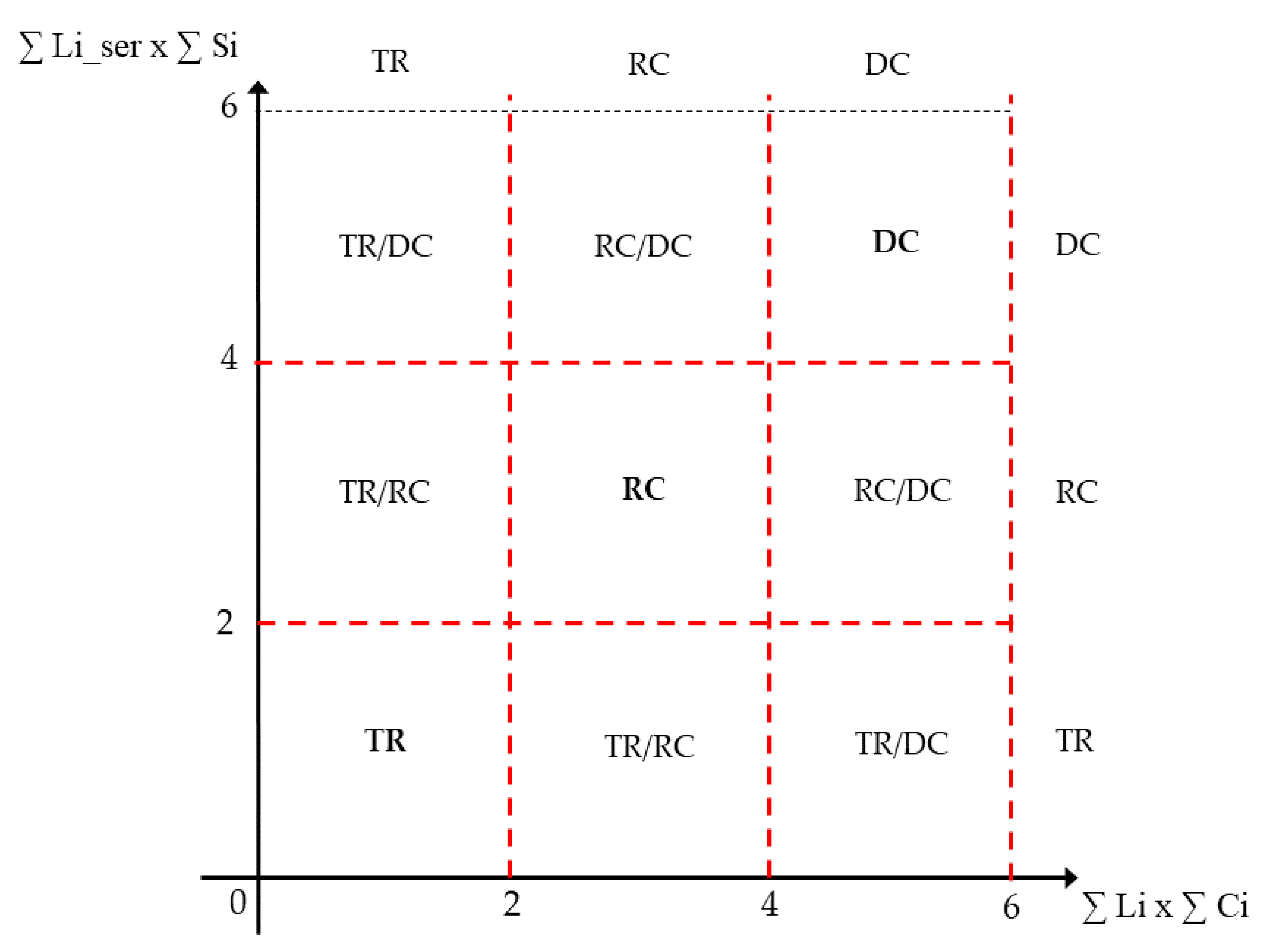
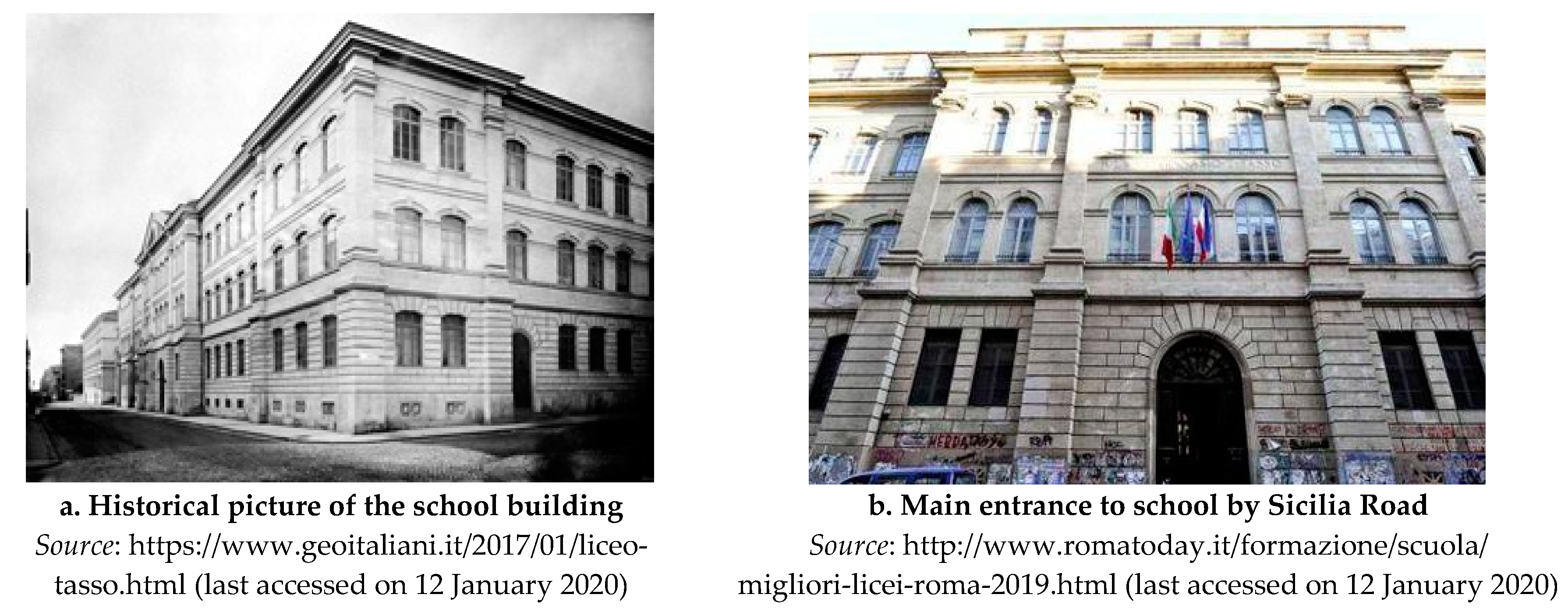
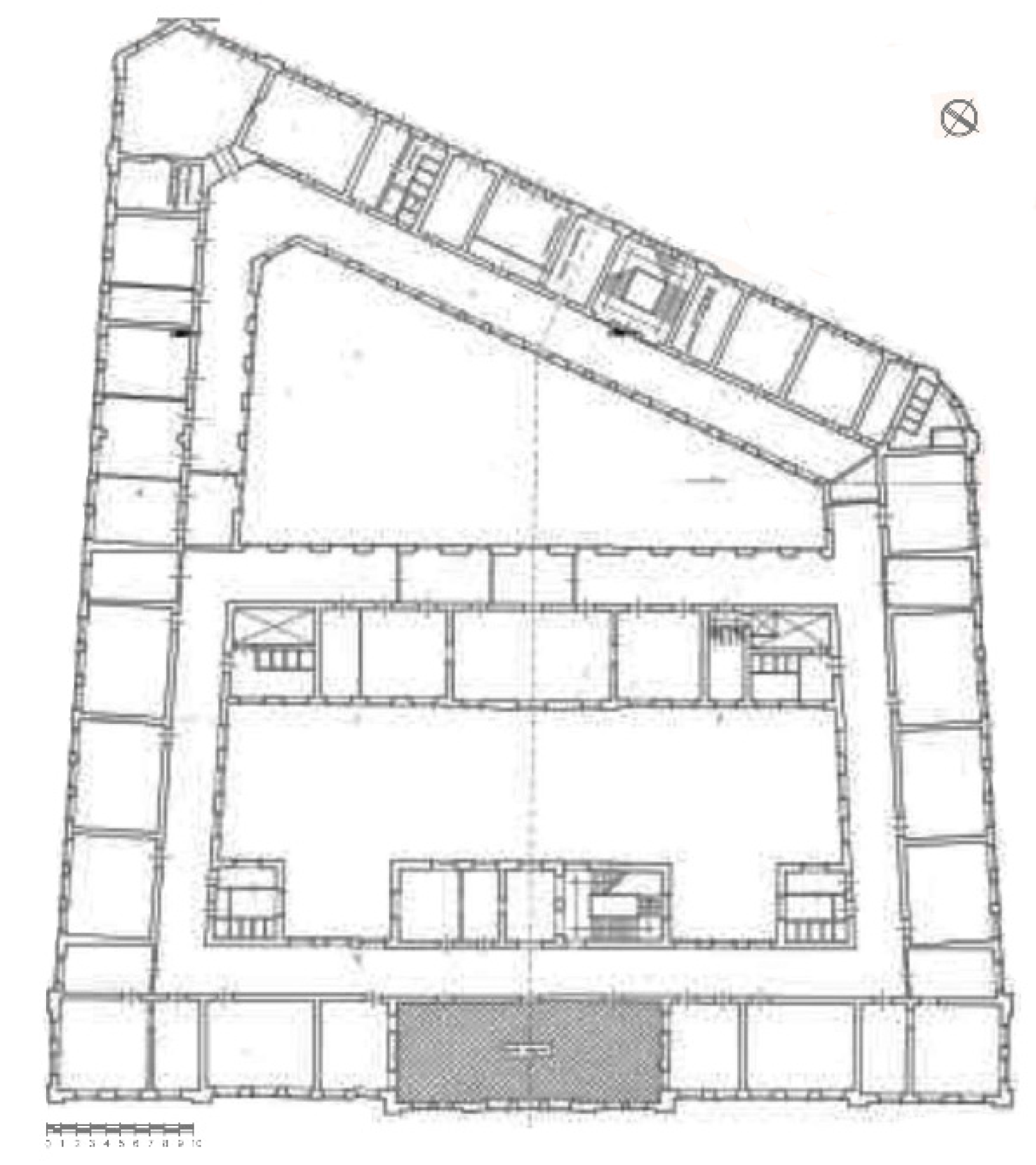
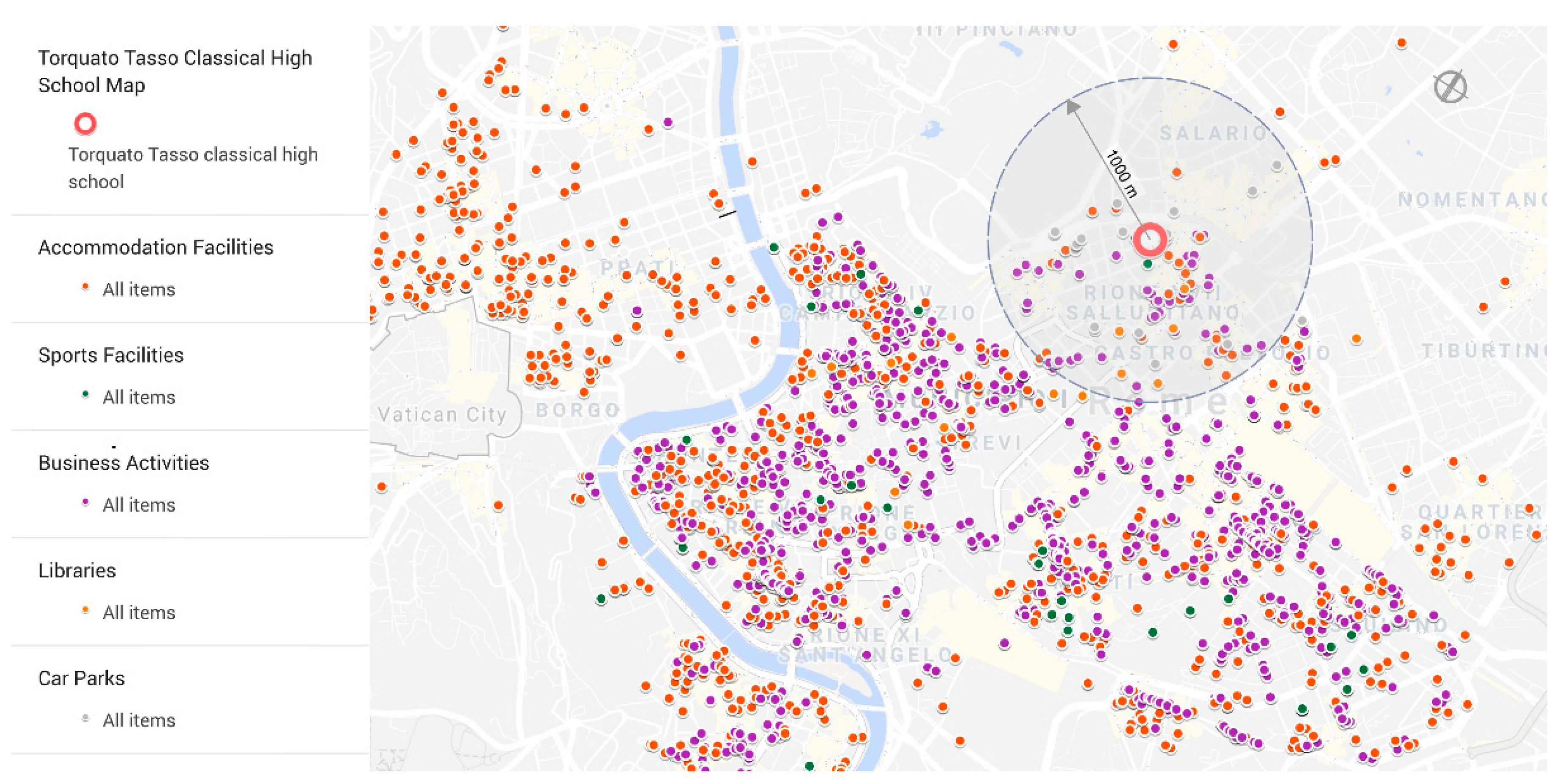
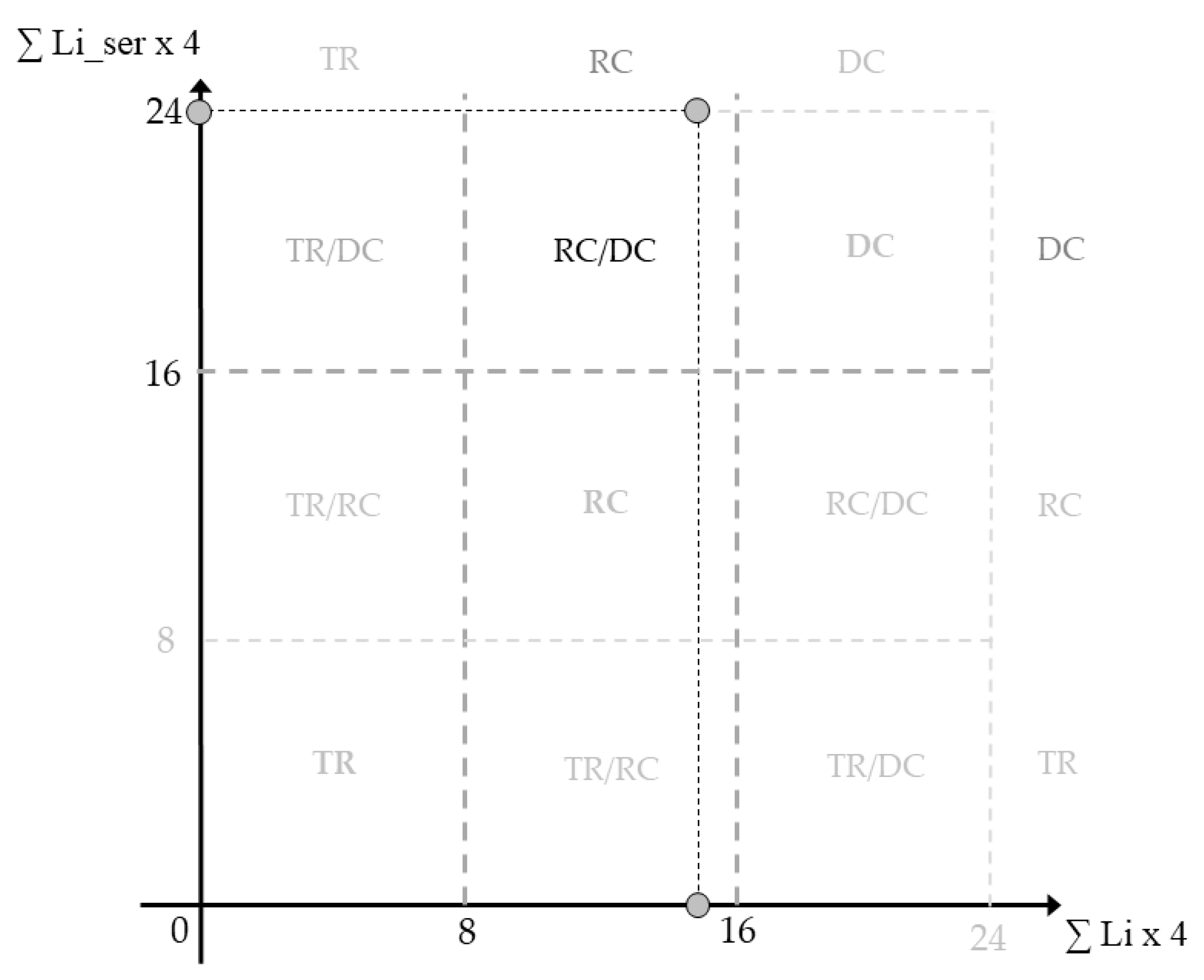
| Main References for School Buildings | Objective to Be Pursued | Evaluation Criteria |
|---|---|---|
| Ministerial Decree of 18 December 1975 | Provide technical standards for school buildings | Respect of the per capita surface area allocation for each space |
| Law n° 23/1996 | Collect information on the building to renewal | Check and acquisition of the data availability relating to the school |
| Legislative Decree n° 106/2009 | Proposals of interventions for the safety of school spaces from pollutants and harmful factors | Control of the implementation of interventions to remove polluting materials |
| Agreement 18 November 2010 | Establish lines of action for the prevention of indoor risk factors | Check of the implementation of measures to prevent surface condensation inside the spaces used for teaching |
| Ministerial Decree of 17 January 2018 | Define security parameters for existing buildings | Possible inactivity of internal/external spaces to school building |
| Information Type | Reference Source | Usefulness Information |
|---|---|---|
| Geographical location and morphology of the building | Data from: ARES questionnaire; Research at the State Historical Archives and inspections carried out at the school | The reconstruction of the history of the school provides information on its possible maintenance, adaptation and renovation |
| Type of educational offer and total number of students enrolled | Data from ARES questionnaire | The characterization of the school in terms of education and number of students provides an indication of the type of education offered |
| Aggregate measurement of the consistencies of the spaces arranged on each floor of which the school is composed | Data from: ARES questionnaire; Survey campaign conducted in each space inside and/or outside the school building | Knowledge of the surface area of each environment inside and/or outside the school is necessary information to verify the per-capita budget that must be guaranteed to each student. |
| Types of services offered (didactic and extra) | School Self-Assessment Report (SAR) | The specification of the services offered by the school during extra-curricular hours shows how the school is used |
| Reference Range of Values of the Parameter Ki_t,ser | Intervention Modalities |
|---|---|
| (Ci, Si) ≤ Ki_t,ser ≤ = (Ci, Si) | Total Renovation |
| (Ci, Si) ≤ Ki_t,ser ≤ (Ci, Si) | Regulatory Compilance |
| (Ci, Si) ≤ Ki_t,ser ≤ (Ci, Si) | Distributional Challenge |
| Academic Year (a.y.) | 2015–2016 | 2016–2017 | 2017–2018 | 2018–2019 | 2019–2020 |
|---|---|---|---|---|---|
| N° of students enrolled in the first year | 795 | 800 | 820 | 942 | 919 |
| N° of classes | 35 | 35 | 35 | 38 | 35 |
| N° of sections | 7 | 7 | 7 | 11 | 7 |
| Type of Spaces | Geometric Dimensions | N° of Rooms | ||||
|---|---|---|---|---|---|---|
| Wide [m] | Long. [m] | Height [m] | Sup. [sqm] | Vol. [mc] | ||
| SCHOOL CLASSES | N° Class-Rooms | |||||
| Large | 10.50 | 7.54 | 4.70 | 79.17 | 372.10 | 1 |
| Middle | 9.30 | 6.30 | 4.70 | 58.59 | 275.37 | 5 |
| Small | 6.50 | 5.70 | 4.70 | 37.05 | 174.14 | 7 |
| Tot. | 631.47 | 821.607 | 13 | |||
| SPACES FOR SPECIAL ACTIVITIES (PHYSICS, CHEMISTRY, NATURAL SCIENCES) | ||||||
| Lab. ART | 4.60 | 8.00 | 4.70 | 36.80 | 172.96 | 1 |
| Art Class-room | 6.41 | 5.27 | 4.70 | 33.78 | 33.78 | 1 |
| Biology Classroom | 8.13 | 8.00 | 4.70 | 65.04 | 65.04 | 1 |
| Tot. | 135.62 | 271.78 | 3 | |||
| BATHROOMS (B)—CONNECTIVE | N° restroom | |||||
| B 1 | 8 | 4.2 | 4.7 | 33.6 | 157.92 | 2 |
| B 2 | 4.5 | 6.2 | 4.7 | 27.9 | 131.13 | 2 |
| Connective | 4.2 | 223.24 | 4.7 | 937.61 | 4406.76 | |
| TOT. | 1060.61 | 4695.81 | 4 | |||
| GYMS (G) | ||||||
| G 1 | - | - | - | - | - | |
| Tot. | - | - | ||||
| SPACES FOR COLLECTIVE ACTIVITIES | ||||||
| Library | 13.71 | 12.91 | 4.70 | 177.00 | 831.88 | 1 |
| Great Hall | 9.36 | 24.42 | 6 | 228.57 | 1371.43 | 1 |
| Natural Science Museum | 8.00 | 23.22 | 4.7 | 185.76 | 873.07 | 1 |
| Tot. | 405.57 | 2203.31 | 3 | |||
| SPACES FOR COMPLEMENTARY ACTIVITIES | ||||||
| Atrium | - | - | - | - | - | |
| Administrative Offices | 8.51 | 57.61 | 4.70 | 490.26 | 2304.23 | 1 |
| Tot. | 490.26 | 2304.23 | 1 | |||
| Types of Spaces | Surfaces | No. of Rooms Per Floor |
|---|---|---|
| 1. INDOOR SPACES | ||
| 1.1 School Classes | 1623.00 m2 | 13 |
| 1.2 Spaces for special activities | 135.62 m2 | 3 |
| 1.3 Bathrooms—Connectives | 2244.22 m2 | 4 |
| 1.4 Internal gyms | 457.86 m2 | 0 |
| 1.5 Spaces for collective activities | 716.85 m2 | 3 |
| 1.6 Spaces for complementary activities | 490.26 m2 | 1 |
| 2. EXTERNAL SPACES | ||
| 2.1 Surfaces used for outdoor sports activities | 311.25 m2 | 1 |
| 2.2 Parking spaces | 0.00 m2 | 0 |
| FUNCTIONAL DISTRIBUTION | ||||||
|---|---|---|---|---|---|---|
| CLASSIFICATION OF SPACES | Sup. [sqm] | Sup Ind. (If) | Sup Ind. (If*) | ∆Ifi [%] | Implementation of the Methodology (b.1) for the Identification of the Score to Be Attributed to Li_f | Li_f |
| Spaces for pedagogical units (Class) | ||||||
| TOT. | 1623 | 1.72 | 1.96 | −12.4 |  | 3 |
| Spaces for special activities (Sas) | ||||||
| TOT. | 135.62 | 0.17 | 0.86 | −80.0 |  | 1 |
| Connections and Toilets (Con.) | ||||||
| TOT. | 2244.22 | 0.49 | 1.81 | −72.9 |  | 1 |
| Spaces for physical education (Sef) | ||||||
| TOT. | 457.86 | 0.49 | 0.94 | −0.49 |  | 1 |
| Spaces for collective activity (Sac) | ||||||
| TOT. | 716.85 | 0.87 | 0.86 | +1.15 |  | 4 |
| Administrative spaces (Sa) | ||||||
| TOT. | 490.26 | 0.60 | 0.23 | +1.63 |  | 4 |
| Lf_tot = ∑ Li_f = | 14 | |||||
| Lf = Lf_tot/6 = | 2,3 | |||||
© 2020 by the authors. Licensee MDPI, Basel, Switzerland. This article is an open access article distributed under the terms and conditions of the Creative Commons Attribution (CC BY) license (http://creativecommons.org/licenses/by/4.0/).
Share and Cite
Guarini, M.R.; Morano, P.; Sica, F. Historical School Buildings. A Multi-Criteria Approach for Urban Sustainable Projects. Sustainability 2020, 12, 1076. https://doi.org/10.3390/su12031076
Guarini MR, Morano P, Sica F. Historical School Buildings. A Multi-Criteria Approach for Urban Sustainable Projects. Sustainability. 2020; 12(3):1076. https://doi.org/10.3390/su12031076
Chicago/Turabian StyleGuarini, Maria Rosaria, Pierluigi Morano, and Francesco Sica. 2020. "Historical School Buildings. A Multi-Criteria Approach for Urban Sustainable Projects" Sustainability 12, no. 3: 1076. https://doi.org/10.3390/su12031076
APA StyleGuarini, M. R., Morano, P., & Sica, F. (2020). Historical School Buildings. A Multi-Criteria Approach for Urban Sustainable Projects. Sustainability, 12(3), 1076. https://doi.org/10.3390/su12031076







